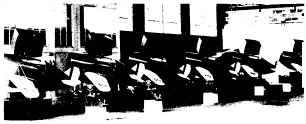The "Blue Box" trainers provided by the now viable and newly incorporated (1935) Link Aviation Devices, Inc., were initially used to train Army pilots responsible for delivering the U.S. Mail. But the direction of pilot training soon changed as the country began building its resources to meet the threat of World War II.

Trainers provided by Link boosted the Allied effort during the war as the device became a vital part of pilot training for more than half a million Allied airmen. "Link Time" became a common term in pilot circles. The company employed 1,500 people and turned out a trainer at the rate of one every 45 minutes.
In the years following World War II, Link Aviation continued to keep pace with the growing aeronautics industry. With the emergence of computer technology, the company designed and constructed a computer-actuated flight trainer and the first jet instrument trainer.
Link continued to grow and expand. The introduction of more sophisticated simulation techniques not only led to the training of pilots for commercial jets, high-performance military aircraft and helicopters, but it also played a leading role in the training of astronauts for the Gemini and Apollo space programs. One of Link’s contribution to the space program—the Shuttle Mission Simulator—was developed to train the crews in all phases of the space shuttle mission from launch to reentry and landing.
The growth of Link Aviation, its expanding flight simulation technology and its future potential induced General Precision Equipment, Inc., to buy the company in 1954. Fourteen years later, The Singer Company purchased Link from GPE and has guided the company’s growth since then.

Note: This data was copied from a Employment Brochure printed mid to late 70's.(jeh)
HOME
